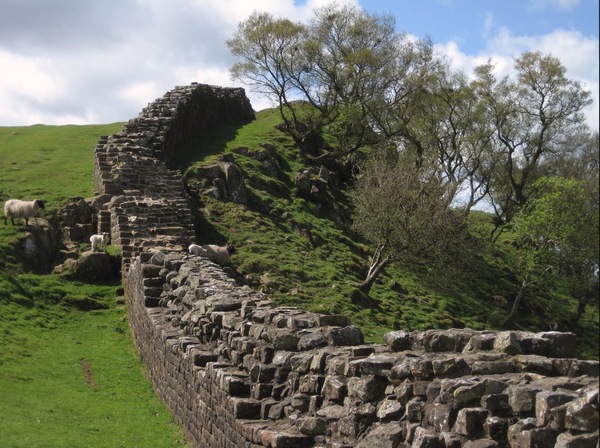
–>
October 30, 2022
“Those who don’t know history are destined to repeat it,” said George Santayana. He could well be describing modern leftists, careening back into the dark ages of post-Roman Britain.
‘); googletag.cmd.push(function () { googletag.display(‘div-gpt-ad-1609268089992-0’); }); }
At the end of the 2nd century AD, Britain was a fully developed province of the Roman Empire. It was as Roman as any city in the Empire. While still largely rural, Roman Britain developed towns and cities that mirrored those found in Italy or North Africa and connected them with a spectacular roadway. They had majestic villas, sprawling estates, baths, plumbing and, of course, aqueducts. The Romans brought industrial sophistication to mining, unprecedented architectural capabilities, and improved agriculture. The province was awash in imported goods from around the Empire: Wine from Gaul, olive oil from Hispania, pottery from North Africa, and philosophy teachers from Greece; all the while exporting precious metals, agricultural products, shellfish, and salt across the Empire.
One of the extraordinary things about the Roman Empire was the unprecedented, widespread prosperity it created from the Pillars of Hercules to the Levant and virtually everywhere in between. While there had always been a market for fine goods such as silk, porcelain, and exotic foods, the Romans brought those goods to the masses. By building roads, ports, and transportation hubs, and funding the trade necessary to support the Legions, the Romans drove economies of scale and created a mass market for goods that had formerly been available only to the rich. In doing so, they created a cosmopolitan empire so thoroughly Roman that people from what are today Morocco, Britain, Germany, and Israel likely spoke some version of the same language and would have found familiar products available wherever they were in the Empire.
In Britain, 300 years after Caesar’s first invasion in 55 BC, the province was a sophisticated, shining example of all the Empire had to offer. It was not to last, however. In less than a century after the Romans abandoned the island for good in 410, the population collapsed, the economy collapsed, cities became ghost towns or disappeared, and chaos reigned. Londinium, which had 60,000 people in the 2nd century, dropped below 20,000 and saw more than 75% of its buildings dismantled, with the materials carted off into the countryside.
‘); googletag.cmd.push(function () { googletag.display(‘div-gpt-ad-1609270365559-0’); }); }
In less than a century, Roman Britain went from a rich, flourishing cosmopolitan province with bustling urban centers and goods from across the known world to an economic and cultural backwater where modern architectural, plumbing, and farming techniques seemed to have disappeared along with most of the imported goods.
Most of the people living on the island in the middle of the 4th century probably assumed, as most 2022 Americans do, that civilization’s advances move only in one direction—upward. They expected to continue to enjoy inexpensive food and pottery and clothing from elsewhere while selling their wares in return. The government would continue to protect them and maintain the ports and roads that facilitated trade.

Image: Hadrian’s Wall by Johnnie Shannon. CC BY 2.0.
When those things didn’t happen, life in Britain became a far darker experience. Cities disappeared, warlords set up fiefdoms, and invaders came from seemingly everywhere. Farming techniques were lost, building techniques were lost, trade collapsed, and citizens were forced to become self-sufficient as numerous petty would-be “kings” set up trade and travel barriers, and goods from the Continent became scarce. The opposite of economies of scale and free trade took hold, so Britain became far less prosperous as goods became more expensive, countless products and varieties of products simply disappeared, and staples had to be produced locally.
It’s here where Santayana’s warning becomes relevant. Given that the history of post-Roman Britain so clearly demonstrates the fragility of civilization’s advances, we might want to pay attention. The reality is, our world, far more tenuously than the Britain of 1700 years ago, is but “X” bad decisions away from an agrarian, subsistence economy with no electricity, no gas, little trade, few economies of scale and, most certainly, no security or safety.
Go through a day and see how many things we rely on that we couldn’t replace if a disaster occurred. Imagine a blackout. How many things would that loss of electricity affect? Not only the lighting in our homes but the refrigerators, phone chargers…everything. Outside our homes, there’s even more: Elevators. Gas pumps. Plumbing. Street lamps and stop lights. Virtually everything in a hospital. Cell phone towers. Police switchboards and dispatches. Train signals and countless other things.
Then there are the social aspects of such a crisis. Rules and laws would go out the window very quickly. During the New York City blackout of 1977, crime surged, with looting, vandalism, and arson rampant (over 1,000 fires were set), while police arrested 3,776 people in the largest mass arrest in the city’s history. The chaos cost over $1 billion in today’s dollars, and the lights were off for less than 24 hours!
‘); googletag.cmd.push(function () { googletag.display(‘div-gpt-ad-1609268078422-0’); }); } if (publir_show_ads) { document.write(“
Now jump forward to the BLM/Antifa riots of 2020. With police under attack, not only was there chaos and mayhem, there were murders, assaults, and rapes nationwide. Communities literally burned to the ground. Then there is the mass looting and random violence that has occurred since 2020 and seems to be growing worse every day—and through all of this, we still had electricity!
Of course, electricity is only one element keeping our society civilized. There’s gasoline, trade, and what used to be widespread respect for the rule of law. Imagine no diesel fuel. Trucks wouldn’t be able to deliver food and store shelves would go bare. You probably have enough food in your kitchen for your family to last a few days or maybe a week at most. Then what? Are you going to grow wheat on your windowsill or in your backyard? Is the neighborhood stray cat going to be your family’s next meal? Do you have a cow for milk? Not to mention medicines, building materials, gasoline for your car… The list of goods delivered via diesel is endless.
One of the downsides of trade, division of labor, and economies of scale is that most of us are dependent on others to provide for us those things we don’t produce for ourselves, which is to say, almost everything. Our society is based on a trade system where we get paid to do some things, and we pay others to do the things we don’t. It’s a well-oiled machine…until it’s not.
And that’s the point. The climate alarmists who want to do away with fossil fuels have no concept of the ramifications of that folly. The equity cultists who want to eliminate the police and “reform” the justice system don’t care about the consequences of that absurdity.
Just as the razor-thin layer of atmosphere surrounding the earth sustains life on earth, our modern society thrives thanks to plentiful, inexpensive energy and respect for the rule of law. Inexplicably, those are the two primary targets of the Democrats who are currently in charge of wide swaths of the United States. Indeed, Californians regularly endure the absurd manmade disaster of rolling blackouts while Illinois is about to essentially decriminalize crime.
When Americans step into their well-lit, safe, and private voting booths on November 8, they’d do well to think of those 5th-century Britains who were about to careen into a darkness from which it would take almost a millennia to emerge…and then vote accordingly.
<!– if(page_width_onload <= 479) { document.write("
“); googletag.cmd.push(function() { googletag.display(‘div-gpt-ad-1345489840937-4’); }); } –> If you experience technical problems, please write to [email protected]
FOLLOW US ON
<!–
–>
<!– _qoptions={ qacct:”p-9bKF-NgTuSFM6″ }; ![]() –> <!—-> <!– var addthis_share = { email_template: “new_template” } –>
–> <!—-> <!– var addthis_share = { email_template: “new_template” } –>





